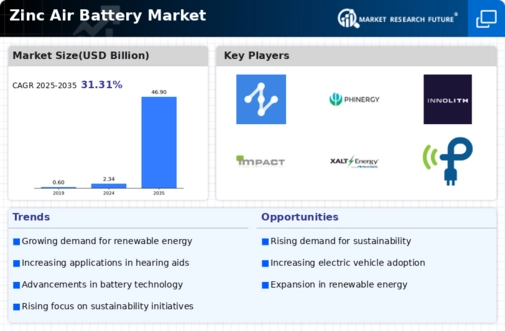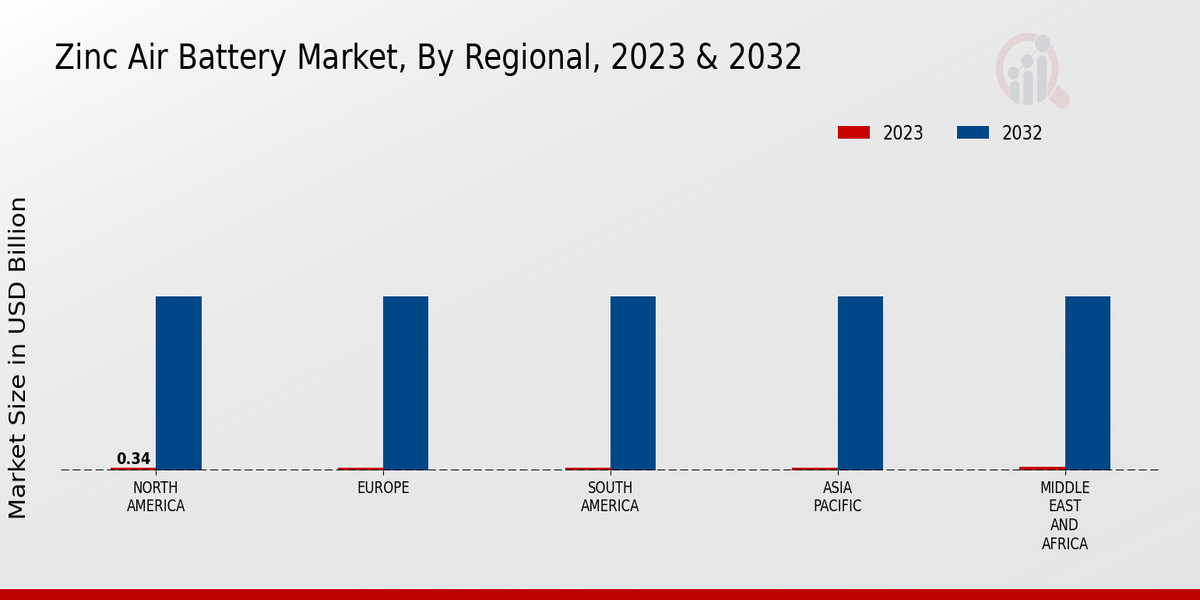Market Growth Projections
The Global Zinc Air Battery Market Industry is poised for remarkable growth, with projections indicating a market value of 2.34 USD Billion in 2024 and a staggering 46.9 USD Billion by 2035. This growth trajectory suggests a compound annual growth rate (CAGR) of 31.32% from 2025 to 2035, reflecting the increasing adoption of zinc air batteries across various applications. The market dynamics are influenced by factors such as technological advancements, rising demand for renewable energy storage, and the growing electric vehicle sector, all contributing to a robust future for zinc air battery technologies.
Rising Electric Vehicle Adoption
The Global Zinc Air Battery Market Industry is also benefiting from the rapid adoption of electric vehicles (EVs). As governments worldwide implement stricter emissions regulations and promote electric mobility, the demand for advanced battery technologies is escalating. Zinc air batteries, with their high energy density and lightweight characteristics, present a viable alternative to conventional lithium-ion batteries in EV applications. This shift is expected to drive significant market growth, with projections suggesting that the market could reach 46.9 USD Billion by 2035, underscoring the potential of zinc air batteries in the automotive sector.
Government Support and Incentives
Government initiatives and incentives aimed at promoting clean energy technologies are significantly impacting the Global Zinc Air Battery Market Industry. Various countries are implementing policies to support research and development in battery technologies, including zinc air batteries. These initiatives often include funding for innovative projects, tax incentives for manufacturers, and subsidies for consumers adopting sustainable energy solutions. Such support is likely to accelerate the growth of the market, fostering an environment conducive to innovation and expansion in the zinc air battery sector.
Advancements in Battery Technology
Technological advancements in battery design and manufacturing are propelling the Global Zinc Air Battery Market Industry forward. Innovations such as improved electrode materials and enhanced electrolyte formulations are enhancing the performance and lifespan of zinc air batteries. These developments not only increase energy efficiency but also reduce production costs, making zinc air batteries more competitive against traditional battery technologies. As a result, the market is likely to experience substantial growth, with a projected compound annual growth rate (CAGR) of 31.32% from 2025 to 2035, indicating a robust future for this technology.
Environmental Sustainability Initiatives
Increasing awareness of environmental sustainability is influencing the Global Zinc Air Battery Market Industry positively. Zinc air batteries are considered more environmentally friendly compared to traditional batteries, as they utilize abundant and non-toxic materials. This aligns with global efforts to reduce carbon footprints and promote sustainable practices across various industries. As organizations and governments prioritize eco-friendly solutions, the demand for zinc air batteries is likely to rise, further solidifying their position in the energy storage market. The focus on sustainability is expected to play a pivotal role in shaping the future landscape of the industry.
Growing Demand for Renewable Energy Storage
The Global Zinc Air Battery Market Industry is witnessing a surge in demand driven by the increasing need for efficient energy storage solutions, particularly in renewable energy applications. As countries transition towards sustainable energy sources, the ability to store energy generated from solar and wind becomes crucial. Zinc air batteries offer a high energy density and are environmentally friendly, making them suitable for integration with renewable energy systems. This trend is expected to contribute significantly to the market, with projections indicating a market value of 2.34 USD Billion in 2024, reflecting the growing adoption of these technologies.



















